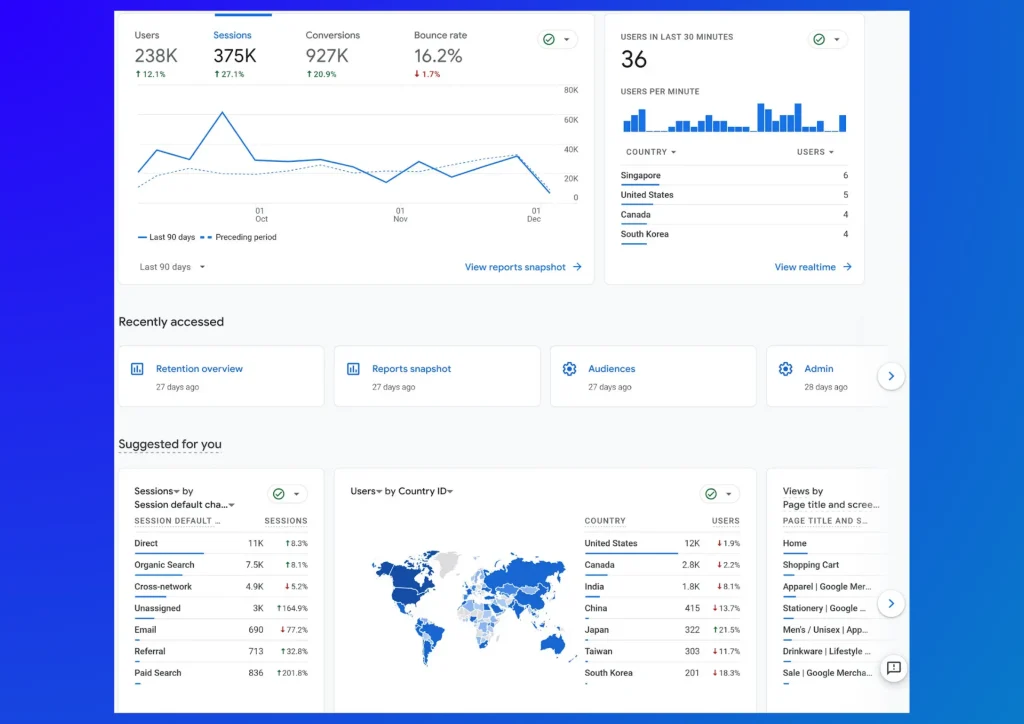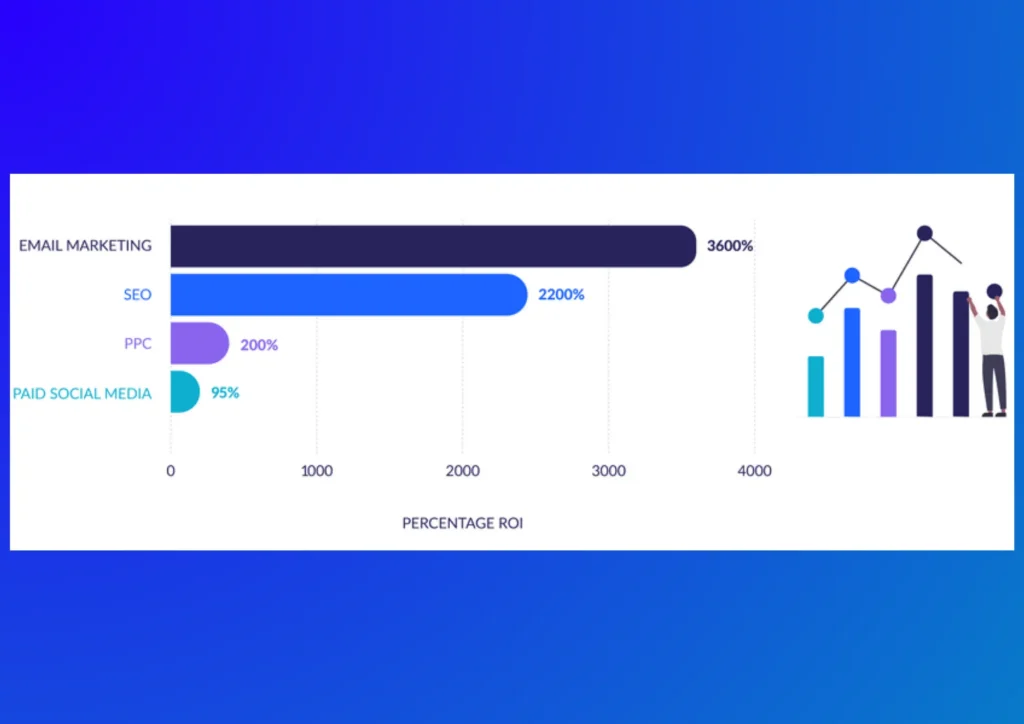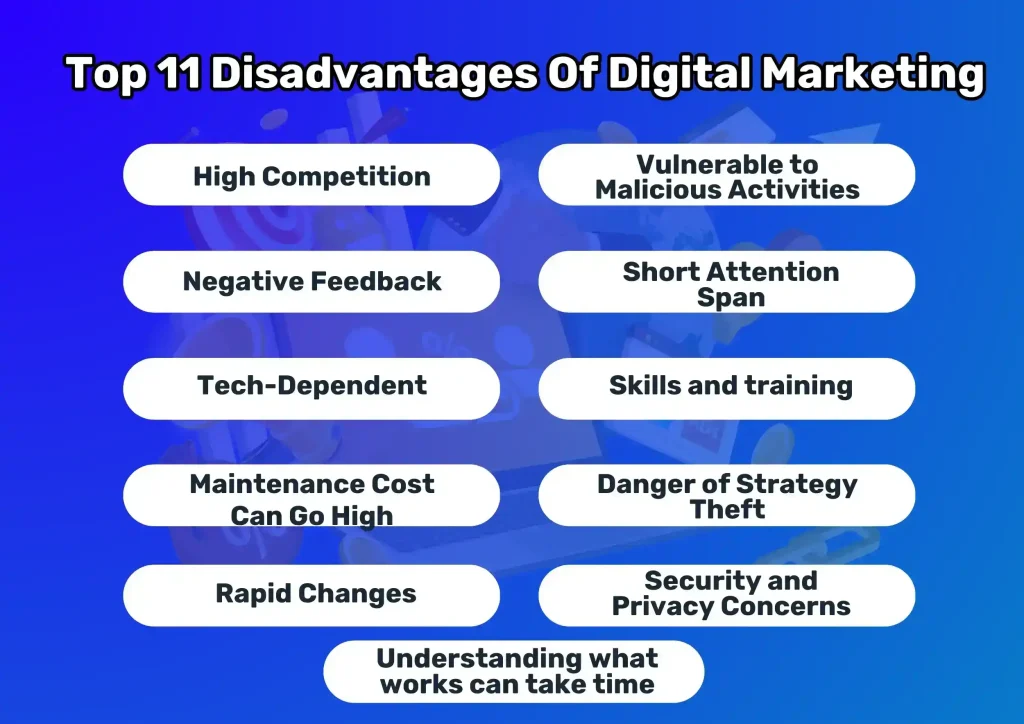What are the top Pros and Cons of Digital Marketing in 2024?

Digital marketing has transformed the way businesses connect with customers since its inception in the early 1990s. As an experienced IT service provider, we’ve seen firsthand the pros and cons of digital marketing—such as its cost-effectiveness, precise targeting, and measurable results versus the challenges of adapting to constant algorithm changes and increased competition. These factors have driven a significant shift from traditional methods like print advertising, radio, and television to digital platforms.
At Elite IT Team, we offer a comprehensive range of digital marketing services to help businesses effectively reach their target audiences and achieve their marketing objectives. Our services include search engine optimization (SEO), pay-per-click (PPC) advertising, social media marketing, content marketing, and email marketing. In this blog post, we will explore the top pros and cons of digital marketing in detail and share insights on how it can drive your business’s success.
The Top Pros and Cons of Digital Marketing in 2024:
There are numerous pros and cons of digital marketing. While it offers increased reach, improved targeting, and enhanced measurement capabilities, it also presents challenges such as the need for ongoing optimization and the competitive nature of the digital landscape. Let’s have a comprehensive look at what are the advantages and disadvantages of digital marketing strategies.
11 Pros of Digital Marketing:
There are many benefits of digital marketing. Below are some of the most important advantages discussed in detail.
1) Building Brand Development:
Brand development is the process of creating a strong and recognizable brand identity. It involves developing a brand name, logo, tagline, and messaging that resonates with your target audience. Digital marketing is a powerful tool for brand development. It allows you to reach a wider audience and create a more engaging brand experience.
Digital marketing can help you to build brand awareness by increasing your online visibility. It can also help you to create a positive brand image by sharing your brand story and values. A recent study by HubSpot found that 83% of consumers say they are more likely to do business with a company that is transparent about its practices. Digital marketing can help you to be transparent by sharing your company’s values and mission.
2) Boosts Consumer Loyalty:
Digital marketing is a powerful tool that can help businesses build strong and lasting relationships with their customers. Digital marketing for startups is also essential. By using digital channels to reach out to potential and existing customers, businesses can create a positive and engaging brand experience that fosters loyalty.
One of the most effective ways to improve brand loyalty through digital marketing is to create high-quality content that resonates with your target audience. This could include blog posts, articles, infographics, videos, or social media posts. By providing valuable and informative content, you can position your brand as a thought leader in your industry and build trust with your customers.
3) Receive Immediate Customer Insights:
One of the significant advantages of digital marketing is the ability to receive instant feedback from customers. This agility is a stark contrast to the slower pace of traditional marketing vs digital marketing, where feedback often comes with a significant delay. This immediate feedback is invaluable for businesses looking to refine their strategies and make data-driven decisions. By tracking metrics such as website traffic, social media engagement, and customer responses, marketers can receive real-time insights into customer preferences, opinions, and behaviours.
Moreover, if a digital ad isn’t performing well, and if you are not getting results with paid advertising, marketers can quickly adjust their approach or allocate resources to more promising channels. This level of responsiveness is crucial in today’s fast-paced competitive landscape.
4) Measure and Track Results:
Another positive aspect of digital marketing is the ability to measure and track results with precision. Unlike traditional marketing methods, which often rely on subjective assessments, digital marketing provides a wealth of data that can be analysed to gauge campaign effectiveness. Key metrics for tracking digital marketing success include website traffic, conversion rates, social media engagement, email open rates, and return on investment (ROI).
By monitoring these metrics, businesses can gain valuable insights into customer behaviour, identify areas for improvement, and make data-driven decisions. Tools like Google Analytics 4 (GA4) and Google Search Console (GSC) are essential for tracking and analysing digital marketing performance. Also, digital marketing is particularly important for small businesses as it allows them to compete with larger corporations on a more level playing field. By utilising digital channels, small businesses can reach a wider audience, build brand awareness, and drive sales at a fraction of the cost.
5) Increase Engagement with Consumers:
One of the most powerful aspects of digital marketing is its ability to foster deeper engagement with consumers. Through platforms like Instagram, businesses can share visually appealing content, participate in conversations, and build meaningful relationships with their audience. By creating engaging content, such as behind-the-scenes glimpses, user-generated content, and interactive polls, businesses can encourage active participation and cultivate a loyal customer base. This can result in increased social media engagement for your business.
6) Improved Market Analysis:
Digital marketing provides valuable insights into consumer behaviour and market trends. By analysing data from various digital channels, businesses can gain a deeper understanding of their target audience, identify emerging opportunities, and make informed decisions. Additionally, it is often asked how to use AI in digital marketing. An answer to this question is, AI-powered tools can automate data analysis, uncover hidden patterns, and provide predictive insights, further enhancing market analysis capabilities.
7) Improved ROI:
While talking about the pros and cons of E-marketing, it is important to mention that digital marketing offers a more measurable and trackable approach to marketing, allowing businesses to calculate return on investment (ROI) with greater accuracy. By tracking key metrics such as website traffic, conversion rates, and social media engagement, businesses can assess the effectiveness of their e-marketing campaigns and make data-driven decisions to optimise their spending.
8) Global Reach:
Unlike traditional marketing, which often has limitations in terms of geographical reach, digital marketing provides businesses with the opportunity to connect with audiences worldwide. By leveraging online platforms, search engines, and understanding the online advertising advantages and disadvantages, businesses can target specific demographics, interests, and locations. This approach allows for a more expansive customer base beyond local boundaries, though it is crucial to navigate the potential challenges that come with online advertising.
For instance, by incorporating relevant keywords and targeting specific regions within Google Ads, a local bakery can effectively reach potential customers in neighbouring cities or even countries, increasing their visibility and attracting new clientele. Additionally, social media platforms offer powerful tools for targeting audiences based on location, interests, and demographics. This enables businesses to deliver personalised content to potential customers, regardless of their physical location, fostering the growth of social media followers organically.
9) Obtrusive and User Engaging Content:
Unlike traditional marketing methods like door-to-door sales, digital marketing offers a more non-intrusive and engaging way to reach potential customers. Through personalised content and targeted advertising, businesses can deliver relevant information to their audience at the right time and place. This avoids the annoyance of unsolicited interruptions and fosters a more positive brand perception.
For instance, a well-crafted email campaign can provide valuable information or exclusive offers to subscribers, while social media posts can engage users through interactive polls, or content. This tailored approach ensures that the content resonates with the target audience, increasing the likelihood of engagement and conversion of website visitors into customers.
10) Can Test Different Strategies:
When discussing the advantages and disadvantages of e-Marketing, it is important to mention the flexibility digital marketing offers to experiment with various strategies and measure their effectiveness. Unlike traditional marketing, where changes often require significant time and resources, digital marketing allows for rapid testing and iteration. By A/B testing different elements of your campaigns, such as headlines, visuals, or calls to action, you can identify which approaches resonate best with your target audience and optimise your efforts accordingly. This flexibility is crucial for maximising your ROI and achieving your marketing goals.
11) Personalised Messaging:
Digital marketing empowers businesses to deliver personalised messages to their target audience. By using data analytics and customer behaviour tracking, businesses can adjust their content, offers, and recommendations to individual preferences. This personalised approach fosters a stronger connection with customers, increases engagement, and drives higher conversion rates. For example, a retail website can recommend products based on a customer’s browsing history, while an email marketing campaign can offer personalised discounts or exclusive content.
Top 11 Disadvantages Of Digital Marketing:
While digital marketing offers numerous benefits, it’s important to acknowledge that it also comes with certain challenges. In this section, we will explore some of the key disadvantages that businesses may encounter when adopting digital marketing strategies. By understanding both the pros and cons of digital marketing, businesses can make informed decisions about their marketing strategies and mitigate potential risks.
1) High Competition:
The digital landscape is highly competitive, with businesses of all sizes vying for attention. This intense competition can make it challenging to stand out and reach your target audience. To overcome this challenge, businesses must continuously innovate, create high-quality content, and leverage effective digital marketing strategies.
2) Negative Feedback:
In the digital age, negative feedback can spread rapidly online, damaging a business’s reputation. It’s crucial to monitor online reviews and address negative comments promptly and professionally. Engaging with customers and resolving issues can help mitigate the impact of negative feedback.
3) Tech-Dependent:
Digital marketing today depends significantly on cutting-edge gadgets and digital devices, making it essential for businesses to stay resilient against potential technical issues. With the rapid pace of algorithm changes and advancements in mobile applications, maintaining a competitive edge requires constant adaptation to the latest technologies. Businesses should not only keep their digital marketing strategies updated but also establish contingency plans to handle unexpected fluctuations and outages. This proactive approach helps prevent disruptions in service and ensures smooth operations. By embracing the latest technologies and remaining agile, businesses can effectively leverage digital marketing for sustained growth and customer satisfaction.
4) Maintenance Cost Can Go High:
Managing a successful digital marketing campaign requires ongoing maintenance and updates. This can lead to higher costs compared to traditional marketing methods. Factors such as website maintenance, content creation, and social media management can contribute to increased expenses.
5) Rapid Changes:
The digital landscape is constantly evolving, with new technologies and trends emerging regularly. Businesses must stay updated with these changes to adapt their strategies and avoid falling behind. This requires ongoing learning and investment in digital marketing education.
6) Vulnerable to Malicious Activities:
Digital marketing can be susceptible to malicious activities such as hacking, phishing, and malware attacks. Businesses must implement robust security measures to protect their online assets and customer data. This includes using strong passwords, regularly updating software, and monitoring for signs of security breaches.
7) Short Attention Span:
In the age of information overload, consumers have shorter attention spans. This makes it challenging to create content that captures and holds audience interest. Businesses must strive to create engaging and visually appealing content that delivers value and encourages interaction.
8) Skills and training:
Effective digital marketing requires specialised skills and training. Businesses may need to invest in employee development or hire professionals with expertise in areas such as SEO, social media marketing, and content creation.
9) Danger of Strategy Theft:
Competitors may closely monitor and analyse a business’s digital marketing strategies. This can lead to the theft of ideas and tactics, potentially eroding a competitive advantage. To mitigate this risk, businesses can implement strategies to protect their intellectual property and differentiate their approach.
10) Understanding What Works Can Take Time:
Digital marketing is a complex field, and it can take time to identify the strategies and tactics that work best for a particular business. Experimentation, data analysis, and continuous optimization are essential for uncovering effective approaches. This process may involve trial and error, but the insights gained can ultimately lead to significant improvements in digital marketing performance.
11) Security and Privacy Concerns:
As businesses collect and store customer data, they face increasing concerns about security and privacy. Data breaches can have severe consequences for a company’s reputation and financial standing. It’s essential to comply with data protection regulations and implement robust security measures to safeguard customer information.
Conclusion:
We have discussed both pros & cons of digital marketing in detail. It is important to note that digital marketing offers a wide range of benefits for businesses in today’s digital landscape. From improved brand loyalty and increased engagement to enhanced market analysis and global reach, the advantages of digital marketing are undeniable. However, it’s important to acknowledge that digital marketing also comes with certain challenges, such as high competition, negative feedback, and the need for ongoing maintenance.
By carefully considering the pros and cons of digital marketing and implementing effective strategies, businesses can harness the power of this powerful tool to achieve their marketing goals and thrive in the competitive digital marketplace. Ultimately, the success of digital marketing depends on a business’s ability to adapt to the ever-evolving digital landscape, embrace innovation, and leverage the latest technologies to reach and engage their target audience.
Table of Contents
Frequently Asked Questions:
The four C’s in digital marketing refer to Customer, Cost, Convenience, and Communication. These elements focus on understanding customer needs, balancing costs, ensuring convenience, and maintaining effective communication.

Zara Finch
Zara, an experienced professional in the SEO industry for the past two years, is passionate about discussing technology, innovations, and the ever-evolving digital landscape. With a keen interest in exploring the latest trends and developments, she brings valuable insights and expertise to her work.





